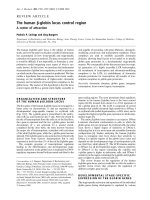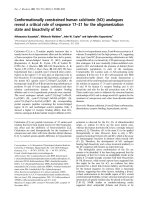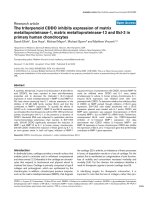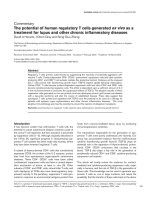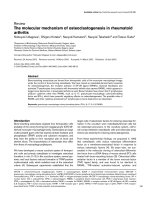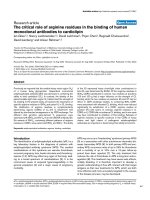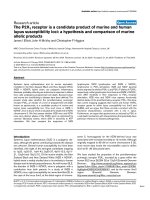Báo cáo y học: "The proliferative human monocyte subpopulation contains osteoclast precursors" ppt
Bạn đang xem bản rút gọn của tài liệu. Xem và tải ngay bản đầy đủ của tài liệu tại đây (860.7 KB, 6 trang )
Open Access
Available online />Page 1 of 6
(page number not for citation purposes)
Vol 11 No 1
Research article
The proliferative human monocyte subpopulation contains
osteoclast precursors
Roya Lari
1
, Peter D Kitchener
2
and John A Hamilton
1
1
Department of Medicine and Cooperative Research Centre for Chronic Inflammatory Diseases, University of Melbourne, The Royal Melbourne
Hospital, Parkville, Victoria 3050, Australia
2
Department of Anatomy and Cell Biology, University of Melbourne, Parkville, Victoria 3010, Australia
Corresponding author: John A Hamilton,
Received: 18 Jun 2008 Revisions requested: 31 Jul 2008 Revisions received: 19 Jan 2009 Accepted: 17 Feb 2009 Published: 17 Feb 2009
Arthritis Research & Therapy 2009, 11:R23 (doi:10.1186/ar2616)
This article is online at: />© 2009 Lari et al.; licensee BioMed Central Ltd.
This is an open access article distributed under the terms of the Creative Commons Attribution License ( />),
which permits unrestricted use, distribution, and reproduction in any medium, provided the original work is properly cited.
Abstract
Introduction Immediate precursors of bone-resorbing
osteoclasts are cells of the monocyte/macrophage lineage.
Particularly during clinical conditions showing bone loss, it
would appear that osteoclast precursors are mobilized from
bone marrow into the circulation prior to entering tissues
undergoing such loss. The observed heterogeneity of peripheral
blood monocytes has led to the notion that different monocyte
subpopulations may have special or restricted functions,
including as osteoclast precursors.
Methods Human peripheral blood monocytes were sorted
based upon their degree of proliferation and cultured in
macrophage colony-stimulating factor (M-CSF or CSF-1) and
receptor activator of nuclear factor-kappa-B ligand (RANKL).
Results The monocyte subpopulation that is capable of
proliferation gave rise to significantly more multinucleated, bone-
resorbing osteoclasts than the bulk of the monocytes.
Conclusions Human peripheral blood osteoclast precursors
reside in the proliferative monocyte subpopulation.
Introduction
Rheumatoid arthritis (RA) is a chronic disease that is charac-
terized by joint inflammation and profound focal and general-
ized bone loss due to the action of osteoclasts [1,2].
Multinucleated osteoclasts derive from monocyte/macro-
phage lineage precursors; two key mediators controlling their
development are macrophage colony-stimulating factor (M-
CSF or CSF-1) and receptor activator of nuclear factor-kappa-
B ligand (RANKL) [3-5]. Human osteoclast precursors have
been shown to be present at low frequency in normal periph-
eral blood [6-8]. It now appears that peripheral blood mono-
cytes, which derive from bone marrow precursors, are
heterogeneous as judged by criteria such as surface marker
expression, size, and function [9]. For example, in the human,
there is a minor subpopulation of monocytes which is CD14
lo
CD16
+
[10] and which has been implicated in inflammation
and cancer [11-13]; in the mouse, there is a lot of recent inter-
est in monocyte subpopulations that appear to have different
roles during inflammatory reactions as manifested, for exam-
ple, by their ability to migrate to sites of inflammation [14].
Human osteoclast precursors have recently been shown to
reside in the CD14
+
CD16
-
monocyte subpopulation of normal
donors [15]. Blood samples from psoriatic arthritis patients,
particularly those with bone erosions visible on plain radio-
graphs, exhibit an increase in osteoclast precursors compared
with those from healthy controls [16]; these precursors were
recently reported to reside in the CD14
lo
CD16
+
monocyte
subset, leading the authors to suggest that osteoclasts are
derived from distinct monocyte subsets in these patients and
in healthy individuals [17].
Human monocytes are commonly considered to be non-prolif-
erating [18]; however, we and others have defined a subpop-
ulation of human monocytes which is capable of proliferating
in vitro (for example, in response to M-CSF) [19-25]. This pop-
ulation has been referred to as proliferative monocytes (PMs),
α-MEM: alpha-minimum essential medium; Cath K: cathepsin K; CFSE: carboxyfluorescein diacetate-succinimidyl ester; CTR: calcitonin receptor;
FBS: fetal bovine serum; Hi-FBS: heat-inactivated fetal bovine serum; M-CSF: macrophage colony-stimulating factor; NP: non-proliferative; PBMC:
peripheral blood mononuclear cell; PBS: phosphate-buffered saline; PCR: polymerase chain reaction; PM: proliferative monocyte; RA: rheumatoid
arthritis; RANK: receptor activator of nuclear factor-kappa-B; RANKL: receptor activator of nuclear factor-kappa-B ligand; TRAP: tartrate-resistant
acid phosphatase.
Arthritis Research & Therapy Vol 11 No 1 Lari et al.
Page 2 of 6
(page number not for citation purposes)
which were shown recently to have the phenotype CD14
+
CD16
-
CD64
+
CD33
+
CD13
lo
c-Fms
+
prior to culture [25]. It
was previously suggested that PMs might be able to migrate
into inflamed tissues and possibly undergo local proliferation
there [19,25]. During these prior phenotyping studies, it was
noticed in passing that, following culture and sorting by flow
cytometry, the PMs, from the few donors studied, could give
rise to tartrate-resistant acid phosphatase-positive (TRAP
+
)
multinucleated cells upon culture in M-CSF + RANKL [25].
Based on this preliminary observation and the likelihood that
the PMs represent a relatively less mature monocyte popula-
tion on account of their ability to proliferate, it was reasoned
that they may retain differentiation capability and therefore
contain the osteoclast precursors. We present evidence here
for this concept for the peripheral blood from normal donors.
Materials and methods
Peripheral blood mononuclear cell isolation, CFSE
labeling, and cell culture
Peripheral blood mononuclear cells (PBMCs) were isolated
following Ficoll centrifugation and labeled with carboxyfluores-
cein diacetate-succinimidyl ester (CFSE) (Molecular Probes
Inc., now part of Invitrogen Corporation, Carlsbad, CA, USA)
as described previously [25]. CFSE-labeled PBMCs were
seeded onto non-treated 100-mm dishes (Iwaki; Asahi Techno
Glass Corporation, Funabasi City, Japan) at a concentration of
3 to 5 × 10
7
cells per dish and allowed to adhere overnight in
alpha-minimum essential medium (α-MEM) (JRH Biosciences,
now part of SAFC Biosciences, Lenexa, KS, USA) containing
L-glutamine (2 mM; Invitrogen Corporation) and penicillin (100
U/mL)/streptomycin (100 μg/mL) (Invitrogen Corporation).
Non-adherent cells were washed away, and new medium was
added (α-MEM containing 3% heat-inactivated fetal bovine
serum [Hi-FBS]) (CSL, Parkville, Victoria, Australia) with M-
CSF (8,000 U/mL) (Chiron, Emeryville, CA, USA). These cul-
tures were incubated at 37°C in 5% CO
2
for 9 days with a
change of medium and removal of non-adherent cells every 3
days.
Cell sorting
The CFSE-stained cells were incubated in ice-cold phos-
phate-buffered saline (PBS) for 30 minutes and harvested by
gentle scraping with a rubber policeman. Cells were resus-
pended in fluorescence-activated cell sorting (FACS) buffer
(PBS containing 1% FBS) (Invitrogen Corporation) and 1 mM
ethylenediaminetetraacetic acid (EDTA) (Ajax Chemicals,
Cheltenham, Victoria, Australia) at a density of 10
7
cells per
millilitre. Propidium iodide solution (3 μL of 1 mg/mL; Sigma-
Aldrich, St. Louis, MO, USA) was added immediately prior to
sorting. CFSE fluorescence levels were determined by flow
cytometry. The appearance of a peak with high fluorescence
intensity (CFSE
hi
) indicated the cells that had not divided. Half
the fluorescence intensity (CFSE
lo
) indicated cells that have
undergone one division. The existence of multiple peaks in
some samples indicated multiple cell divisions in those popu-
lations [25]. CFSE-labeled cells were then sorted using a
FACSVantage SE (BD Biosciences, San Jose, CA, USA).
Osteoclast generation from peripheral blood
mononuclear cells
Sorted cells were cultured at 3 × 10
4
cells per well (in α-MEM
and 3% Hi-FBS) in M-CSF (8,000 U/mL; Chiron) with or with-
out RANKL (50 ng/mL; PeproTech, Rocky Hill, NJ, USA).
These cultures were incubated at 37°C in 5% CO
2
for up to
21 days; the culture medium, including the relevant mediators,
was changed twice per week. For the bone resorption assay,
bone slices (horse cortical femur) were added to the well prior
to the addition of the cells.
Tartrate-resistant acid phosphatase staining
Osteoclast differentiation was determined firstly by TRAP
staining following fixation in formaldehyde and acetone/alco-
hol as described previously [26]. Briefly, following fixation,
cells were stained with freshly prepared TRAP staining solu-
tion (naphthol AS-MX phosphate, fast red violet LB salt, and
potassium sodium tartrate). Osteoclast formation was evalu-
ated by counting the TRAP
+
multinucleated (n ≥ 3) cells.
mRNA extraction and quantitative reverse transcription-
polymerase chain reaction analyses
Cells were plated at a density of 5 × 10
5
in 3 mL/well of
medium (α-MEM and 3% Hi-FBS) in the presence of M-CSF
(8,000 U/mL) with or without RANKL (50 ng/mL) in 6-cm tis-
sue culture dishes (Becton, Dickinson and Company, Franklin
Lakes, NJ, USA). Cells were incubated for 14 days with a com-
plete change of medium every 3 to 4 days. Total RNA was iso-
lated with the RNAeasy kit (Qiagen Inc., Valencia, CA, USA) in
accordance with the instructions of the manufacturer. cDNAs
were synthesized as described previously [27]. Pre-Devel-
oped TaqMan Assay Reagents (Applied Biosystems,
Scoresby, Victoria, Australia) were used for cDNA sequence
analysis for calcitonin receptor (CTR) and cathepsin K (Cath
K). Quantitative polymerase chain reaction (PCR) analyses
were used to quantify transcripts with the ABI Prism 7900 HT
Sequence Detection System (Applied Biosystems) as
described previously [27]. For the PCR analyses, fluores-
cence from each sample was measured once each cycle dur-
ing PCR and plotted against cycle number; the earlier a signal
appeared (at a lower cycle number), the higher the concentra-
tion of the template. The cycle threshold (Ct) number was
used to indicate gene expression.
Pit formation assay
Cells were removed from bone slices by brief sonication
(approximately 30 seconds) and lysed in 1% Triton-X 100 for
30 minutes. Haematoxylin was applied to the resorbed surface
of each slice for 1 minute and then the slices were washed
three or four times with tap water. The residual stain was
removed by wiping against absorbent paper. Resorption was
observed by transmission light microscopy. Total pit area and
Available online />Page 3 of 6
(page number not for citation purposes)
total bone area were measured in 10 randomly selected areas
for two or three bone slices by the Scion Image analysis pro-
gram (Scion Corporation, Frederick, MD, USA), and the per-
centage pit area in each group was calculated [28].
Statistical analysis
Data are presented as mean ± standard error. Significant dif-
ferences were determined using the paired Student t test; a P
value of less than or equal to 0.05 was considered significant.
Results
Proliferative monocytes contain precursors of tartrate-
resistant acid phosphatase-positive multinucleated cells
After culture in M-CSF, adherent, CFSE-labeled PBMCs
could be sorted, based on their differing fluorescence intensi-
ties due to the number of cell divisions, into the PM and non-
proliferative (NP) populations [25] (Figure 1). Preliminary data
using PBMCs from three donors indicated that the former, pre-
dominantly spindle-shaped, population contained the bulk of
the precursors which could be converted by culture in M-CSF
+ RANKL into TRAP
+
multinucleated cells with more intense
TRAP staining (that is, possibly osteoclasts) [25]. In a more
complete study, we now present data (Figure 2) for the
number of TRAP
+
multinucleated (n ≥ 3) cells obtained from
PBMCs from 13 donors and it can be seen that in general
there were more of such cells derived from the PM population
(P < 0.001) than from the NP monocyte population, an effect
requiring the presence of RANKL; some multinucleated (n ≥ 3)
cells could be observed even at day 7 in the PM cultures in the
presence of M-CSF and RANKL (data not shown).
Higher osteoclast-associated gene expression in the
proliferative monocyte population following culture in
M-CSF and RANKL
Even though it was presented above that significantly more
TRAP
+
multinucleated cells can be obtained from the PM pop-
ulation, actual osteoclast differentiation needs to be confirmed
as osteoclasts and macrophage polykaryons are morphologi-
cally similar [29]; in addition, TRAP staining does not distin-
guish very well between such populations in the human. We
therefore firstly measured the expression of certain genes
whose products are associated with osteoclast function. In
Figure 3, the results from four donors for CTR and Cath K
mRNA expression following culture in M-CSF + RANKL for 14
days are provided; it can be noted that there was significantly
more expression of these osteoclast-specific genes from the
PM population, which required RANKL to be present (data not
shown). Consistent again with the greater osteoclastogenic
potential of the PMs, their progeny, following culture in M-CSF
+ RANKL, had significantly greater RANK expression when
measured at 14 days, at least at the gene level, when com-
pared with that from the NP cells (data not shown).
Higher bone resorption in the proliferative monocyte
population following culture in M-CSF and RANKL
To confirm the functional activity of the multinucleated cells
produced, bone resorption was measured next. The PM and
NP populations were cultured in tissue culture dishes contain-
ing bone slices in the presence of M-CSF + RANKL. After 3
Figure 1
Sorting proliferative monocyte (PM) and non-proliferative (NP) popula-tion cells after carboxyfluorescein diacetate-succinimidyl ester (CFSE) labeling and cultureSorting proliferative monocyte (PM) and non-proliferative (NP) popula-
tion cells after carboxyfluorescein diacetate-succinimidyl ester (CFSE)
labeling and culture. CFSE-labeled peripheral blood mononuclear cells
were cultured in alpha-minimum essential medium + 3% heat-inacti-
vated fetal bovine serum containing macrophage colony-stimulating
factor (8,000 U/mL) in non-treated dishes for 9 days. The adherent
cells were then sorted based on their CFSE fluorescence intensity as
PM (CFSE
lo
) and NP (CFSE
hi
) populations [25].
Figure 2
Proliferative monocytes (PMs) contain precursors of tartrate-resistant acid phosphatase-positive (TRAP
+
) multinucleated cells (MNCs)Proliferative monocytes (PMs) contain precursors of tartrate-resistant
acid phosphatase-positive (TRAP
+
) multinucleated cells (MNCs). Non-
proliferative (NP) and PM subpopulations from 13 donors, sorted as in
Figure 1, were cultured in duplicate or triplicate cultures in macrophage
colony-stimulating factor (M-CSF) (8,000 U/mL) and receptor activator
of nuclear factor-kappa-B ligand (RANKL) (50 ng/mL) for 21 days;
because insufficient cells were available, the two starting populations
from fewer donors were also cultured in M-CSF alone. TRAP
+
MNCs
were counted. The mean number of such cells was significantly higher
in the PM-derived cells cultured in M-CSF and RANKL compared with
the NP-derived population (*P < 0.001). M, macrophage colony-stimu-
lating factor; R, receptor activator of nuclear factor-kappa-B ligand.
Arthritis Research & Therapy Vol 11 No 1 Lari et al.
Page 4 of 6
(page number not for citation purposes)
weeks, numerous resorption lacunae were found distributed
over the surface of the bone slices in the PM cultures. How-
ever, only a few small resorption pits were observed in the
bone slices cultured with NP cells under the same conditions
(Figure 4).
Discussion
Under steady-state conditions, osteoclastogenesis and bone
remodeling occur mainly in the bone marrow. Osteoclast pre-
cursors can be mobilized from bone marrow into blood and
then into tissues, particularly in some conditions involving
bone loss at diseased sites (for example, RA) [30,31]. At an
early stage of differentiation, they are also able to give rise to
different myeloid populations [32], whereas at a later stage
their differentiation involves M-CSF-dependent action on c-
Fms
+
populations [33].
The heterogeneity of peripheral blood monocytes has led to
the concept that there may be distinct subpopulations of cells
with specialized functions [10,14,34,35]. For example, for the
human, it is known that only a small proportion of monocytes
can differentiate into osteoclasts [36,37]. Likewise, it is known
that a small proportion of CD14
+
human monocytes (that is,
PMs) can proliferate in vitro [19,25]; because of their ability to
Figure 3
Osteoclast gene expression in differentiated proliferative monocyte (PM) and non-proliferative (NP) subpopulationsOsteoclast gene expression in differentiated proliferative monocyte
(PM) and non-proliferative (NP) subpopulations. NP and PM subpopu-
lations, sorted as in Figure 1, were cultured for 14 days in macrophage
colony-stimulating factor (8,000 U/mL) and receptor activator of
nuclear factor-kappa-B ligand (50 ng/mL). Calcitonin receptor (CTR)
and cathepsin K (Cath K) mRNA expression were measured by quanti-
tative polymerase chain reaction. Samples from four individual donors
were tested in triplicate, and data were normalized to 18S expression
for each gene. Values are means of cycle threshold (Ct) numbers that
were obtained in each sample ± standard error. The mean values for
the PM population were significantly lower than those for the corre-
spondingly treated NP population from the same donor (P ≤ 0.05).
Figure 4
Precursors of bone-resorbing cells reside in the proliferative monocyte (PM) populationPrecursors of bone-resorbing cells reside in the proliferative monocyte
(PM) population. Sorted non-proliferative (NP) and PM populations
(Figure 1) were cultured on bovine bone (3 × 10
4
cells per slice) for 21
days in the presence of macrophage colony-stimulating factor (8,000
U/mL) and receptor activator of nuclear factor-kappa-B ligand (50 ng/
mL). (a) The bone slices were stained with haematoxylin (magnification
× 200). Arrows indicate pits on the bone surface. (b) Resorption pit
area measured for four donors (see 'Higher bone resorption in the pro-
liferative monocyte population following culture in M-CSF and RANKL'
section). Values are means of percentage of resorbed bone ± standard
error. For each donor, the mean values for the PM group are signifi-
cantly greater than those for the correspondingly treated NP cells (P <
0.05).
Available online />Page 5 of 6
(page number not for citation purposes)
proliferate, it was reasoned that this less mature population,
possibly representing cells recently mobilized from bone mar-
row, may be able to differentiate into different macrophage lin-
eage populations, such as osteoclasts, under appropriate
conditions.
Taking advantage of the relative ability of monocyte popula-
tions to undergo proliferation, we were able to show above
that, for the blood from 13 donors, osteoclast precursors
reside predominantly in the PM population and could be
detected even after proliferation in M-CSF. Following further
culture in M-CSF and RANKL, the resultant population con-
taining the multinucleated progeny showed increased expres-
sion of certain osteoclast markers (CTR, Cath K, and RANK)
and an ability to resorb bone. These findings are consistent
with the concept that the PMs represent a less mature popu-
lation, when compared with the bulk of the human peripheral
blood monocytes [19-21], with some cells in the PM fraction
at least retaining an ability to differentiate into osteoclasts. The
data presented are consistent with prior observations that
both the PM population [19,25] and osteoclast precursors
[15] from normal individuals reside in the CD14
+
CD16
-
mono-
cytes rather than in the CD14
lo
CD16
+
population, that osteo-
clastic cells can be generated from proliferating dendritic cell
precursors in human peripheral blood [38], and that there is an
early increase in the percentage of human peripheral blood
osteoclast precursors entering S phase during their in vitro dif-
ferentiation in M-CSF + RANKL [39]. It is possible that the
PMs can differentiate while in the blood into NP monocytes
with reduced proliferative and differentiation potential, per-
haps under the influence of circulating M-CSF.
It is intriguing that, in psoriatic arthritis, the opposite finding
has been made in that the increased numbers of peripheral
blood osteoclast precursors noted were located in the CD16
+
population [17]. It would be worth knowing whether the PM
population also increases in this and perhaps other inflamma-
tory conditions and whether they begin to express higher
CD16 levels in vivo. We suggest again [25] that functional cri-
teria, such as PM status, have an advantage over surface
marker phenotyping in that they avoid the difficulty in defining,
for example, for monocyte populations whether modulation in
the expression of a particular surface marker reflects differen-
tiation or activation.
Conclusion
In summary, it has been shown here that human peripheral
blood osteoclast precursors reside in the PM subpopulation,
which is presumably a relatively less mature subpopulation
and therefore possibly recently mobilized from bone marrow
[19-21]. It has been proposed before [19-21,25] that, upon
migration into inflammatory lesions, the PMs may contribute to
the local macrophage proliferation which can be observed
[40,41]. It is also possible that they could reside as osteoclast
precursors in the synovial macrophage population within RA
joints [30] which have been shown capable of differentiation
into osteoclasts [42,43].
Competing interests
The authors declare that they have no competing interests.
Authors' contributions
RL designed and performed the study, analyzed the data, and
drafted the manuscript. PDK performed the statistical analysis.
JAH supervised the study and finalized the manuscript. All
authors read and approved the final manuscript.
Acknowledgements
This work was supported by a grant and a Senior Principal Research
Fellowship (JAH) from the National Health and Medical Research Coun-
cil of Australia. We thank Alice Holloway for sorting the cells, Felix
Clanchy and John Roinotis for providing PBMCs, and Rifa Sallay for edit-
ing the manuscript.
References
1. Romas E, Gillespie MT, Martin TJ: Involvement of receptor acti-
vator of NF[kappa]B ligand and tumor necrosis factor-[alpha]
in bone destruction in rheumatoid arthritis. Bone 2002,
30:340-346.
2. Kong YY, Feige U, Sarosi I, Bolon B, Tafuri A, Morony S, Capparelli
C, Li J, Elliott R, McCabe S, Wong T, Campagnuolo G, Moran E,
Bogoch ER, Van G, Nguyen LT, Ohashi PS, Lacey DL, Fish E,
Boyle WJ, Penninger JM: Activated T cells regulate bone loss
and joint destruction in adjuvant arthritis through osteoprote-
gerin ligand. Nature 1999, 402:304-309.
3. Fuller K, Wong B, Fox S, Choi Y, Chambers TJ: TRANCE is nec-
essary and sufficient for osteoblast-mediated activation of
bone resorption in osteoclasts. J Exp Med 1998,
188:997-1001.
4. Lacey DL, Timms E, Tan HL, Kelley MJ, Dunstan CR, Burgess T,
Elliott R, Colombero A, Elliott G, Scully S, Hsu H, Sullivan J,
Hawkins N, Davy E, Capparelli C, Eli A, Qian YX, Kaufman S,
Sarosi I, Shalhoub V, Senaldi G, Guo J, Delaney J, Boyle WJ: Oste-
oprotegerin ligand is a cytokine that regulates osteoclast dif-
ferentiation and activation. Cell 1998, 93:165-176.
5. Tanaka S, Takahashi N, Udagawa N, Tamura T, Akatsu T, Stanley
ER, Kurokawa T, Suda T: Macrophage colony-stimulating factor
is indispensable for both proliferation and differentiation of
osteoclast progenitors. J Clin Invest 1993, 91:257-263.
6. Matsuzaki K, Udagawa N, Takahashi N, Yamaguchi K, Yasuda H,
Shima N, Morinaga T, Toyama Y, Yabe Y, Higashio K, Suda T:
Osteoclast differentiation factor (ODF) induces osteoclast-like
cell formation in human peripheral blood mononuclear cell
cultures. Biochem Biophys Res Commun 1998, 246:199-204.
7. Quinn JM, Neale S, Fujikawa Y, McGee JO, Athanasou NA:
Human osteoclast formation from blood monocytes, perito-
neal macrophages, and bone marrow cells. Calcif Tissue Int
1998, 62:527-531.
8. Shalhoub V, Elliott G, Chiu L, Manoukian R, Kelley M, Hawkins N,
Davy E, Shimamoto G, Beck J, Kaufman SA, Van G, Scully S, Qi
M, Grisanti M, Dunstan C, Boyle WJ, Lacey DL: Characterization
of osteoclast precursors in human blood. Br J Haematol 2000,
111:501-512.
9. Grage-Griebenow E, Flad HD, Ernst M: Heterogeneity of human
peripheral blood monocyte subsets. J Leukoc Biol 2001,
69:11-20.
10. Passlick B, Flieger D, Ziegler-Heitbrock H: Identification and
characterization of a novel monocyte subpopulation in human
peripheral blood. Blood 1989, 74:
2527-2534.
11. Kawanaka N, Yamamura M, Aita T, Morita Y, Okamoto A,
Kawashima M, Iwahashi M, Ueno A, Ohmoto Y, Makino H: CD14
+
,
CD16
+
blood monocytes and joint inflammation in rheumatoid
arthritis. Arthritis Rheum 2002, 46:2578-2586.
12. Nockher WA, Scherberich JE: Expanded CD14
+
CD16
+
mono-
cyte subpopulation in patients with acute and chronic infec-
Arthritis Research & Therapy Vol 11 No 1 Lari et al.
Page 6 of 6
(page number not for citation purposes)
tions undergoing hemodialysis. Infect Immun 1998,
66:2782-2790.
13. Saleh MN, Goldman SJ, LoBuglio AF, Beall AC, Sabio H, McCord
MC, Minasian L, Alpaugh RK, Weiner LM, Munn DH: CD16
+
monocytes in patients with cancer: spontaneous elevation and
pharmacologic induction by recombinant human macrophage
colony-stimulating factor. Blood 1995, 85:2910-2917.
14. Sunderkotter C, Nikolic T, Dillon MJ, Van Rooijen N, Stehling M,
Drevets DA, Leenen PJ: Subpopulations of mouse blood mono-
cytes differ in maturation stage and inflammatory response. J
Immunol 2004, 172:4410-4417.
15. Komano Y, Nanki T, Hayashida K, Taniguchi K, Miyasaka N: Iden-
tification of a human peripheral blood monocyte subset that
differentiates into osteoclasts. Arthritis Res Ther 2006, 8:R152.
16. Ritchlin CT, Haas-Smith SA, Li P, Hicks DG, Schwarz EM: Mech-
anisms of TNF-alpha- and RANKL-mediated osteoclastogene-
sis and bone resorption in psoriatic arthritis. J Clin Invest
2003, 111:821-831.
17. Chiu Y, Schwarz E, Mensah K, Durham R, Shan T, Ritchlin CT:
Osteoclasts are derived from distinct monocyte subsets in
psoriatic arthritis patients and healthy individuals. Arthritis
Rheum 2007, 56 Suppl 1:S249.
18. van Furth R, Raeburn J, van Zwet T: Characteristics of human
mononuclear phagocytes. Blood 1979, 54:485-500.
19. Finnin M, Hamilton JA, Moss ST: Characterization of a CSF-
induced proliferating subpopulation of human peripheral
blood monocytes by surface marker expression and cytokine
production. J Leukoc Biol 1999, 66:953-960.
20. Moss ST, Hamilton JA: Proliferation of a subpopulation of
human peripheral blood monocytes in the presence of colony
stimulating factors may contribute to the inflammatory proc-
ess in diseases such as rheumatoid arthritis. Immunobiology
2000, 202:18-25.
21. Finnin M, Hamilton JA, Moss ST: Direct comparison of the
effects of CSF-1 (M-CSF) and GM-CSF on human monocyte
DNA synthesis and CSF receptor expression. J Interferon
Cytokine Res 1999, 19:417-423.
22. Bennett S, Por SB, Stanley ER, Breit SN: Monocyte proliferation
in a cytokine-free, serum-free system. J Immunol Methods
1992, 153:201-212.
23. Cheung DL, Hamilton JA: Regulation of human monocyte DNA
synthesis by colony-stimulating factors, cytokines, and cyclic
adenosine monophosphate. Blood
1992, 79:1972-1981.
24. Erickson-Miller CL, Brennan JK, Abboud CN: Examination of sur-
vival, proliferation and cell surface antigen expression of
human monocytes exposed to macrophage colony-stimulat-
ing factor (M-CSF). Int J Cell Cloning 1990, 8:346-356.
25. Clanchy FIL, Holloway AC, Lari R, Cameron PU, Hamilton JA:
Detection and properties of the human proliferative monocyte
subpopulation. J Leukoc Biol 2006, 79:757-766.
26. Quinn JM, Whitty GA, Byrne RJ, Gillespie MT, Hamilton JA: The
generation of highly enriched osteoclast-lineage cell popula-
tions. Bone 2002, 30:164-170.
27. Lari R, Fleetwood AJ, Kitchener PD, Cook AD, Pavasovic D, Hert-
zog PJ, Hamilton JA: Macrophage lineage phenotypes and oste-
oclastogenesis – complexity in the control by GM-CSF and
TGF-beta. Bone 2007, 40:323-336.
28. Wakikawa T, Shioi A, Hino M, Inaba M, Nishizawa Y, Tatsumi N,
Morii H, Otani S: Thrombopoietin inhibits in vitro osteoclas-
togenesis from murine bone marrow cells. Endocrinology
1997, 138:4160-4166.
29. Quinn JM, Morfis M, Lam MH, Elliott J, Kartsogiannis V, Williams
ED, Gillespie MT, Martin TJ, Sexton PM: Calcitonin receptor anti-
bodies in the identification of osteoclasts. Bone 1999, 25:1-8.
30. Xing L, Schwarz EM, Boyce BF: Osteoclast precursors, RANKL/
RANK, and immunology. Immunol Rev 2005, 208:19-29.
31. Udagawa N, Kotake S, Kamatani N, Takahashi N, Suda T: The
molecular mechanism of osteoclastogenesis in rheumatoid
arthritis. Arthritis Res 2002, 4:281-289.
32. Roodman GD: Cell biology of the osteoclast. Exp Hematol
1999, 27:1229-1241.
33. Dai X-M, Ryan GR, Hapel AJ, Dominguez MG, Russell RG, Kapp
S, Sylvestre V, Stanley ER: Targeted disruption of the mouse
colony-stimulating factor 1 receptor gene results in osteopet-
rosis, mononuclear phagocyte deficiency, increased primitive
progenitor cell frequencies, and reproductive defects. Blood
2002, 99:111-120.
34. Wang SY, Mak KL, Chen LY, Chou MP, Ho CK:
Heterogeneity of
human blood monocyte: two subpopulations with different
sizes, phenotypes and functions. Immunology 1992,
77:298-303.
35. Geissmann F, Jung S, Littman DR: Blood monocytes consist of
two principal subsets with distinct migratory properties.
Immunity 2003, 19:71-82.
36. Fujikawa Y, Quinn JM, Sabokbar A, McGee JO, Athanasou NA:
The human osteoclast precursor circulates in the monocyte
fraction. Endocrinology 1996, 137:4058-4060.
37. Massey HM, Flanagan AM: Human osteoclasts derive from
CD14-positive monocytes. Br J Haematol 1999, 106:167-170.
38. Rivollier A, Mazzorana M, Tebib J, Piperno M, Aitsiselmi T, Rabour-
din-Combe C, Jurdic P, Servet-Delprat C: Immature dendritic cell
transdifferentiation into osteoclasts: a novel pathway sus-
tained by the rheumatoid arthritis microenvironment. Blood
2004, 104:4029-4037.
39. Zauli G, Rimondi E, Corallini F, Fadda R, Capitani S, Secchiero P:
MDM2 antagonist Nutlin-3 suppresses the proliferation and
differentiation of human pre-osteoclasts through a p53-
dependent pathway. J Bone Miner Res 2007, 22:1621-1630.
40. Jutila MA, Banks KL: Locally dividing macrophages in normal
and inflamed mammary glands. Clin Exp Immunol 1986,
66:615-624.
41. Bischof RJ, Zafiropoulos D, Hamilton JA, Campbell IK: Exacerba-
tion of acute inflammatory arthritis by the colony-stimulating
factors CSF-1 and granulocyte macrophage (GM)-CSF: evi-
dence of macrophage infiltration and local proliferation. Clin
Exp Immunol 2000, 119:361-367.
42. Danks L, Sabokbar A, Gundle R, Athanasou NA: Synovial macro-
phage-osteoclast differentiation in inflammatory arthritis. Ann
Rheum Dis 2002, 61:916-921.
43. Adamopoulos IE, Sabokbar A, Wordsworth BP, Carr A, Ferguson
DJ, Athanasou NA: Synovial fluid macrophages are capable of
osteoclast formation and resorption. J Pathol 2006, 208:35-43.
